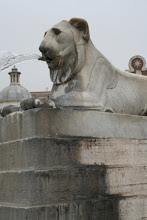Imagine this.
There you are, abandoned as a baby in an English orphanage awaiting adoption. Along comes an Italian princess, childless, with an immense fortune including palaces, villas and a priceless art collection of Caravaggios, Brueghels and the like. She adopts you and a younger baby girl and you go and live in an Italian palazzo in Rome.
Today in Rome the traffic moves constantly from the Vittorio Emanuele monument at the bottom of the via del Corso to the Piazza del Popolo at the top. A large and very grimy palazzo, spanning a couple of city blocks, fronts the Corso and as you walk along you can glimpse a very beautiful internal courtyard, one of four, in the 1,000-room palace.
And most sculptors presented idealised portraits of their subjects.
Lovelier things are to be seen in the gallery, including the salon of mirrors -
and this wonderful painting of the sinners in Paradise, by Jan Brueghel. Note the pair of lions, and the porcupines in the right hand corner. And in the left background, an elephant and two giraffes. Brueghel supposedly hadn't seen many of these exotic animals and hence their positioning away from the main detail of the picture.
So the palazzo is very lovely, and probably very difficult to restore and maintain and it is therefore open to the public to help keep it in private hands. These days the hands belong to the adopted boy and girl from the orphanage, except now they are 50 and 49 years old respectively. Princess Gesine Margaret Orietta Mary Pogson Doria Pamphilj is a devout catholic, married to an Italian, with four daughters and is a staunch upholder of her religion. Prince Jonathan Doria Pamphilj is an openly gay man, in a civil partnership with a Brazilian ex-restauranteur and has two children by surrogacy.
The right of these children to inherit the Doria Pamphilj estate after Jonathan's death was called into question by Princess Gesine Doria, on the basis that the children were born of surrogate mothers. In 2010 a court in Rome declined to hear the case, so it's round one to Prince Jonathan. But as you can imagine, there's huge family ructions over this one.
There you are, abandoned as a baby in an English orphanage awaiting adoption. Along comes an Italian princess, childless, with an immense fortune including palaces, villas and a priceless art collection of Caravaggios, Brueghels and the like. She adopts you and a younger baby girl and you go and live in an Italian palazzo in Rome.
Today in Rome the traffic moves constantly from the Vittorio Emanuele monument at the bottom of the via del Corso to the Piazza del Popolo at the top. A large and very grimy palazzo, spanning a couple of city blocks, fronts the Corso and as you walk along you can glimpse a very beautiful internal courtyard, one of four, in the 1,000-room palace.
Princess Orietta Pogson Doria Pamphilj died in 2000 leaving her two adopted children this palace along with other family treasures, and today you can visit the staterooms, chapel and art- and sculpture-galleries. And as you walk through you can listen to the current Prince Jonathan Doria Pamphilj explain the history of this incredible place intertwined with stories of the family ancestors. These include Pope Innocent X and his scheming sister-in-law, the evil Donna Olimpia, known as La Papessa, due to her constant and effective manipulation of the pope and the papal fortune. Roman legend says the ghost of Donna Olimpia still clatters through the city in her devil carriage. I'd believe it - just have a look at this marble bust of the woman:And most sculptors presented idealised portraits of their subjects.
Lovelier things are to be seen in the gallery, including the salon of mirrors -
and this wonderful painting of the sinners in Paradise, by Jan Brueghel. Note the pair of lions, and the porcupines in the right hand corner. And in the left background, an elephant and two giraffes. Brueghel supposedly hadn't seen many of these exotic animals and hence their positioning away from the main detail of the picture.
So the palazzo is very lovely, and probably very difficult to restore and maintain and it is therefore open to the public to help keep it in private hands. These days the hands belong to the adopted boy and girl from the orphanage, except now they are 50 and 49 years old respectively. Princess Gesine Margaret Orietta Mary Pogson Doria Pamphilj is a devout catholic, married to an Italian, with four daughters and is a staunch upholder of her religion. Prince Jonathan Doria Pamphilj is an openly gay man, in a civil partnership with a Brazilian ex-restauranteur and has two children by surrogacy.
The right of these children to inherit the Doria Pamphilj estate after Jonathan's death was called into question by Princess Gesine Doria, on the basis that the children were born of surrogate mothers. In 2010 a court in Rome declined to hear the case, so it's round one to Prince Jonathan. But as you can imagine, there's huge family ructions over this one.
.jpg)
.jpg)

.jpg)
.jpg)
%2B(683x1024).jpg)
.jpg)
.jpg)
